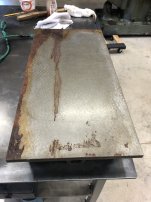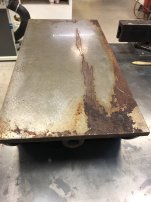marka12161
Stainless
- Joined
- Dec 23, 2016
- Location
- Oswego, NY USA
I recently picked up a Bridgeport and a round dial 10EE from the widow of an elderly gentlemen who passed away. Along with the machine came a pile of tooling and other assorted stuff. Among the pile was a 12 x 24 Brown & Sharpe Cast Iron Surface Plate. As you can see from the pics, there was some localized corrosion which I attacked using a razor blade followed up by some steel wool & kerosene. After this treatment, some pitting is apparent and i suspect the whole top of the plate needs to be rescraped.
I'm not terribly disappointed as I enjoy a good challenge. To date i have made a hand scraper and I think successfully scraped to bottom of a larg-ish cask iron V block to flat. It took me a few hours of practice to get the bluing just the right thickness but once i got the hang of it, all proceeded pretty well with uniformly distributed high points and proper hinging. Anyway, I also own a biax power scraper which I have yet to practice with and need to find the time to make a couple more scrapers with smaller radii blades.
My question is pretty simple, should i take a skim pass over the top of this with a fly cutter on the mill prior to scraping or should i just attack it with a scraper (hand or power)? In 2018 my 3' x 2' granite plate was inspected and certified to Grade A and it's seen little use since then so i'm pretty confident i have a good reference surface.
I'm not terribly disappointed as I enjoy a good challenge. To date i have made a hand scraper and I think successfully scraped to bottom of a larg-ish cask iron V block to flat. It took me a few hours of practice to get the bluing just the right thickness but once i got the hang of it, all proceeded pretty well with uniformly distributed high points and proper hinging. Anyway, I also own a biax power scraper which I have yet to practice with and need to find the time to make a couple more scrapers with smaller radii blades.
My question is pretty simple, should i take a skim pass over the top of this with a fly cutter on the mill prior to scraping or should i just attack it with a scraper (hand or power)? In 2018 my 3' x 2' granite plate was inspected and certified to Grade A and it's seen little use since then so i'm pretty confident i have a good reference surface.





